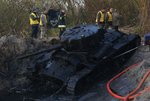From what little information there is available that aircraft (with only two hmgs) seems to be about as fast as a Bf 109 G-6 with the MG151 gondolas... doesn't seem like a good trade.Just adding this
VL Pyorremyrsky

Kris
Always surprised me since it looks rather clean. Then again, it has about 15% more wing area...
Last edited:

